1997 BUICK REGAL check engine light
[x] Cancel search: check engine lightPage 203 of 422

Avoid needless heavy braking. Some people drive in
spurts
-- heavy acceleration followed by heavy
braking
-- rather than keeping pace with traffic. This is a
mistake. Your brakes may not have time to cool between
hard stops, Your brakes will wear
out much faster if you
do a lot of heavy braking. If you keep pace with the
traffic and allow realistic following distances, you will
eliminate
a lot of unnecessary braking. That means
better braking and longer brake life.
If your engine ever stops while you’re driving, brake
normally but don’t pump your brakes.
If you do, the
pedal may get harder to push down. If your engine
stops, you will still have some power brake assist. But
you will use it when you brake. Once the power assist is
used up, it may take longer
to stop and the brake pedal
will be harder to push.
Anti-Lock Brakes (ABS)
Your vehicle has anti-lock brakes (ABS). ABS is an
advanced electronic braking system that will help
prevent a braking skid.
When you start your engine, or when you begin to drive
away, your anti-lock brake system will check itself. You
may hear
a momentary motor or clicking noise while
this test is going on, and you may even notice that your
brake pedal moves a little. This is normal.
ANTI -
LOCK
If there’s a problem with the
anti-lock brake system, this
warning light will stay on or
flash. See “Anti-Lock
Brake System Warning
Light” in the Index.
ProCarManuals.com
Page 283 of 422
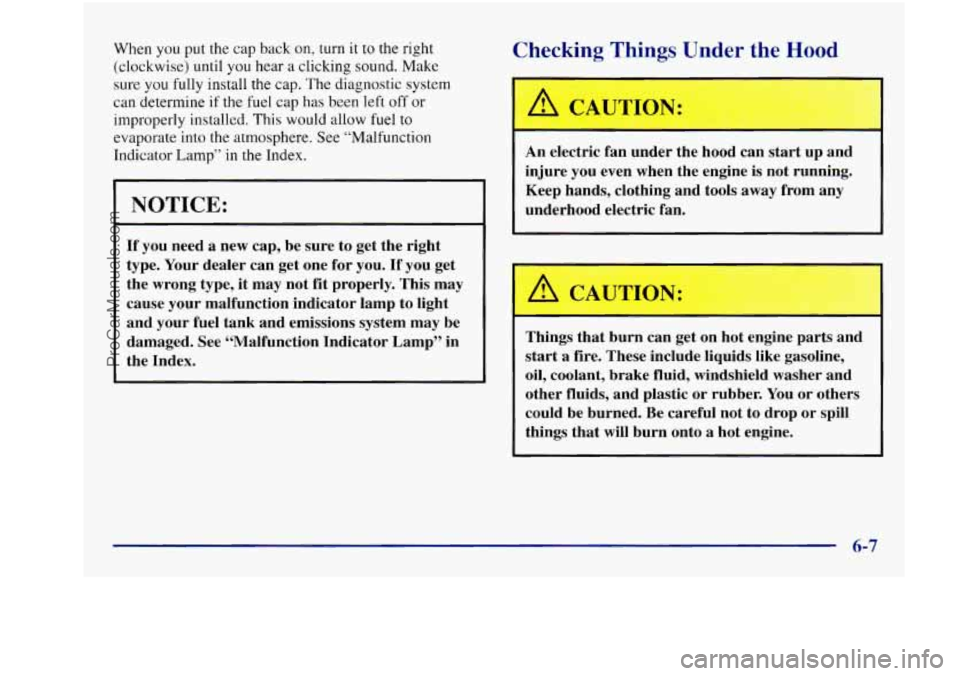
When you put the cap back on, turn it to the right
(clockwise) until
you hear a clicking sound. Make
sure
you fully install the cap. The diagnostic system
can determine
if the fuel cap has been left off or
improperly installed. This would allow fuel to
evaporate into the atmosphere. See “Malfunction
Indicator Lamp” in the Index.
NOTICE:
If you need a new cap, be sure to get the right
type. Your dealer can get one
for you. If you get
the wrong type, it may not
fit properly. This may
cause your malfunction indicator lamp to light
and your
fuel tank and emissions system may be
damaged. See “Malfunction Indicator Lamp” in
the Index.
Checking Things Under the Yood
An electric fan under the hood can start up and
injure you even when the engine is not running.
Keep hands, clothing and tools away from any
underhood electric fan.
Things that burn can get
on hot engine parts and
start a fire. These include liquids like gasoline,
oil, coolant, brake fluid, windshield washer and
other fluids, and plastic or rubber. You or others
could be burned. Be careful not to drop
or spill
things that will burn onto a hot engine.
ProCarManuals.com
Page 287 of 422
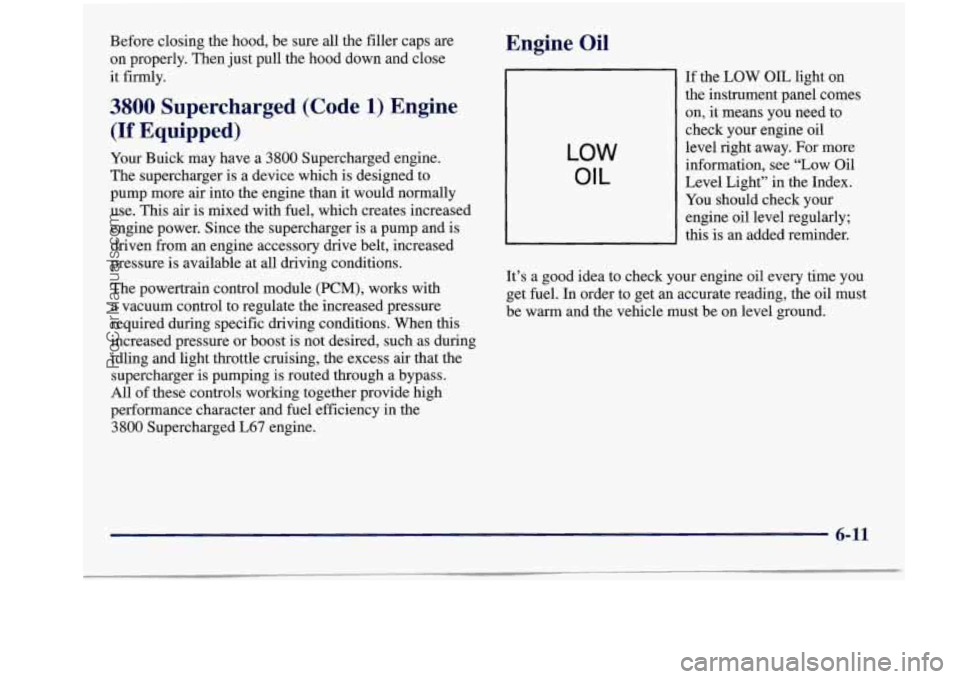
Before closing the hood, be sure all the filler caps are
on properly. Then just pull the hood down and close
it firmly.
3800 Supercharged (Code 1) Engine
(If Equipped)
Your Buick may have a 3800 Supercharged engine.
The supercharger is a device which is designed to
pump more air into the engine than it would normally
use. This air is mixed with fuel, which creates increased
engine power. Since the supercharger is a pump and is
driven from an engine accessory drive belt, increased
pressure is available at all driving conditions.
The powertrain control module
(PCM), works with
a vacuum control to regulate the increased pressure
required during specific driving conditions. When
this
increased pressure or boost is not desired, such as during
idling and light throttle cruising, the excess air that the
supercharger
is pumping is routed through a bypass.
All of these controls working together provide high
performance character and fuel efficiency in the
3800 Supercharged L67 engine.
Engine
I --
LOW
OIL
If the LOW OIL light on
the instrument panel comes on, it means you need to
check your engine oil level right away. For more
information, see
“Low Oil
Level Light” in the Index.
You should check your
engine oil level regularly;
this is an added reminder.
It’s
a good idea to check your engine oil every time you
get fuel. In order to get an accurate reading, the oil must
be warm and the vehicle must be on level ground.
6-11
ProCarManuals.com
Page 300 of 422
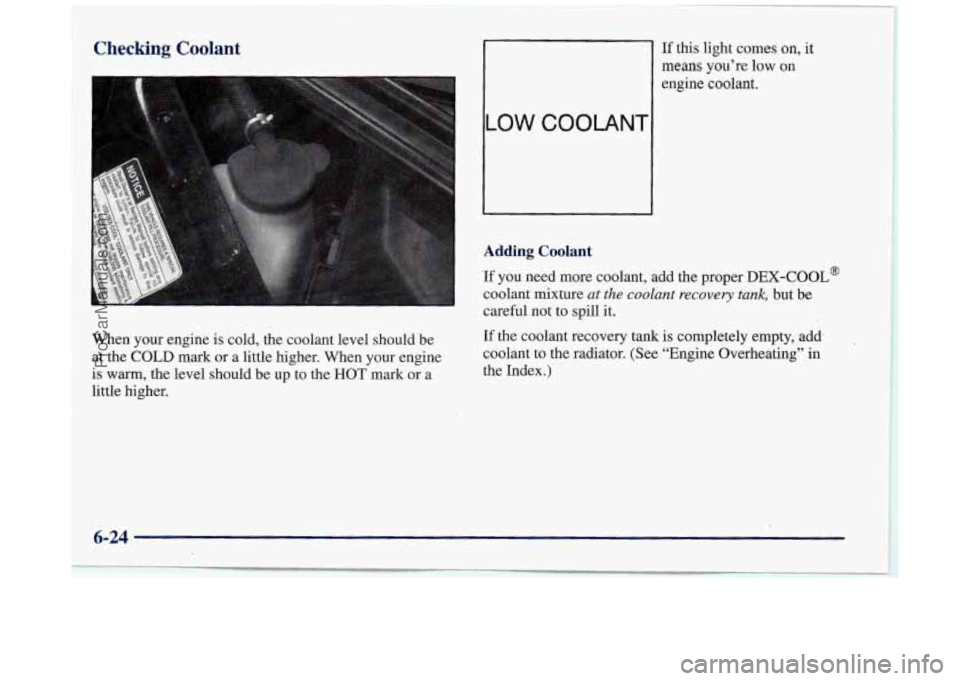
Checking Coolant
When your engine is cold, the coolant level should be
at the COLD mark or a little higher. When your engine
is warm, the level should be up to the HOT mark or a
little higher.
If this light comes on, it
means you’re low on
engine
coolant.
Adding Coolant
If you need more coolant, add the proper DEX-COOL@
coolant mixture at
the coolant recovery tank, but be
careful not to spill it.
If the coolant recovery tank is completely empty, add.
coolant to the radiator. (See “Engine Overheating” in
the Index.)
6-24
ProCarManuals.com
Page 349 of 422
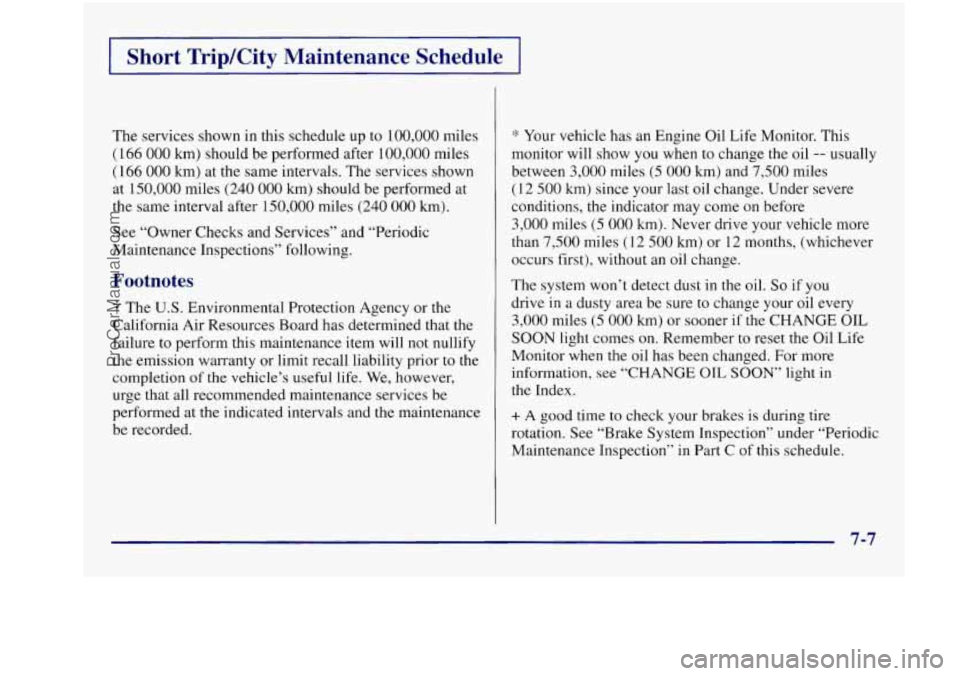
* Your vehicle has an Engine Oil L’
Short TripKity Maintenance Schedule
The services shown in this schedule up to 100,000 miles
(166 000 km) should be performed after 100,000 miles
(166 000 km) at the same intervals. The services shown
at
150,000 miles (240 000 km) should be performed at
the same interval after
150,000 miles (240 000 km).
See “Owner Checks and Services” and “Periodic
Maintenance Inspections” following.
Footnotes
-f The U.S. Environmental Protection Agency or the
California Air Resources Board has determined that the
failure to perform this maintenance item will not nullify
the emission warranty or limit recall liability prior to the
completion of the vehicle’s useful life. We, however,
urge that all recommended maintenance services be
performed at
the indicated intervals and the maintenance
be recorded. ~fe
Monitor. Thi
.s
monitor will show you when to change the oil -- usually
between
3,000 miles (5 000 km) and 7,500 miles
(1 2 500 km) since your last oil change. Under severe
conditions,
the indicator may come on before
3,000 miles (5 000 km). Never drive your vehicle more
than
7,500 miles (1 2 500 km) or 12 months, (whichever
occurs first), without an oil change.
The system won’t detect dust in the oil.
So if you
drive in
a dusty area be sure to change your oil every
3,000 miles (5 000 km) or sooner if the CHANGE OIL
SOON light comes on. Remember to reset the Oil Life
Monitor when the oil has been changed. For more
information, see
“CHANGE OIL SOON” light in
the Index.
+ A good time to check your brakes is during tire
rotation.
See “Brake System Inspection” under “Periodic
Maintenance Inspection” in Part C
of this schedule.
7-7
ProCarManuals.com
Page 370 of 422
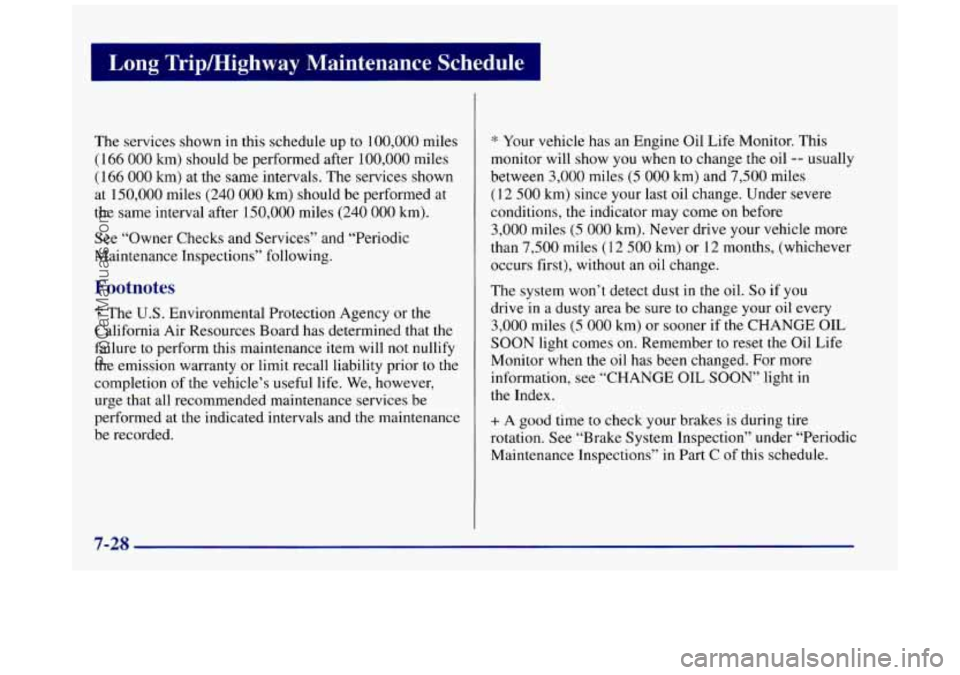
I Long Tripmighway Maintenance Schedule 1
The services shown in this schedule up to 100,000 miles
( 166 000 km) should be performed after 100,000 miles
(166 000 km) at the same intervals. The services shown
at
150,000 miles (240 000 km) should be performed at
the same interval after 150,000 miles
(240 000 km).
See “Owner Checks and Services” and “Periodic
Maintenance Inspections” following.
Footnotes
The U.S. Environmental Protection Agency or the
California Air Resources Board has determined that the
failure to perform this maintenance item will not nullify
the emission warranty or limit recall liability prior to the
completion of the vehicle’s useful life.
We, however,
urge that all recommended maintenance services be
performed at the indicated intervals and the maintenance
be recorded.
* Your vehicle has an Engine Oil Life Monitor. This
monitor will show you when to change the oil
-- usually
between
3,000 miles (5 000 km) and 7,500 miles
(1 2 500 km) since your last oil change. Under severe
conditions, the indicator may come on before
3,000 miles (5 000 km). Never drive your vehicle more
than
7,500 miles (1 2 500 km) or 12 months, (whichever
occurs first), without an oil change.
The system won’t detect dust in the oil.
So if you
drive in a dusty area be sure to change your oil every
3,000 miles (5 000 km) or sooner if the CHANGE OIL
SOON light comes on. Remember to reset the Oil Life
Monitor when the
oil has been changed. For more
information, see “CHANGE OIL
SOON’ light in
the Index.
+ A good time to check your brakes is during tire
rotation.
See “Brake System Inspection” under “Periodic
Maintenance Inspections” in Part
C of this schedule.
7-28
ProCarManuals.com
Page 410 of 422

Driving
........................................ City 4-22
Defensive
.................................... 4-2
Drunken
..................................... 4-3
Freeway
.................................... 4-23
InaBlizzard
................................. 4-29
IntheRain
.................................. 4-19
OnCurves
.................................. 4-12
In Foreign Countries
........................... 6-5
Night
...................................... 4-17
On Grades While Towing a Trailer
............... 4-39
On Hill and Mountain Roads .................... 4-25
On Snow or Ice
.............................. 4-28
Through Deep Standing Water
................... 4-21
With a Trailer
................................ 4-37
Drunken Driving
................................ 4-3
Dual Automatic ComforTemp Climate Control
......... 3-7
Dual ComforTemp Climate Control
.................. 3-4
WetRoads
.................................. 4-19
Winter
...................................... 4-27 Identification
................................ 6-57
Oil Level Check .............................. 7-39
Overheating
................................. 5-15
Running
While Parked ......................... 2-32
Specifications
................................ 6-64
Engine Oil
.................................... 6-11
Additives ................................... 6-15
Supercharger
................................ 6-18
Used
....................................... 6-15
What Kind to Use ............................. 6-13
When to Change
.............................. 6-15
Enhanced Traction System ........................ 4-11
Enhanced Traction System-Active Light
............. 2-64
Enhanced Traction System
Warning Light ........... 2-63
Exhaust, Engine
................................ 2-32
Exterior Lamps ................................. 2-41
StartingYow
................................ 2-20
Adding
..................................... 6-12
Checking
................................... 6-12
Ethan01
........................................ 6.- 4
Electrical Equipment. Adding ..... 2.21.2.53.3.35. 6.58
Electrical System
............................... 6-58
Electrochromic Daymight Rearview Mirror
.......... 2-47
Engine
.............................. 6.9.6.10. 6.11
Coolant
..................................... 6-22
Coolant Heater
............................... 2-21
Coolant Level Check
.......................... 7-39
Coolant Temperature Gage
..................... 2-68
Coolant Temperature Light
..................... 2-68
Exhaust
..................................... 2-32 Fabric
Cleaning
............................... 6-48
Features and Controls
............................ 2-1
Filling Your Tank
................................ 6-5
Filter, Engine Oil
............................... 6-15
Filter, Passenger Compartment Air
................. 6-17
Finish Damage
................................. 6-54
First Gear, Automatic Transaxle
................... 2-26
Flashers, Hazard Warning
......................... 5-2
Filter. Air
..................................... 6-16
Finishcare
.................................... 6-53
9-4
ProCarManuals.com
Page 414 of 422
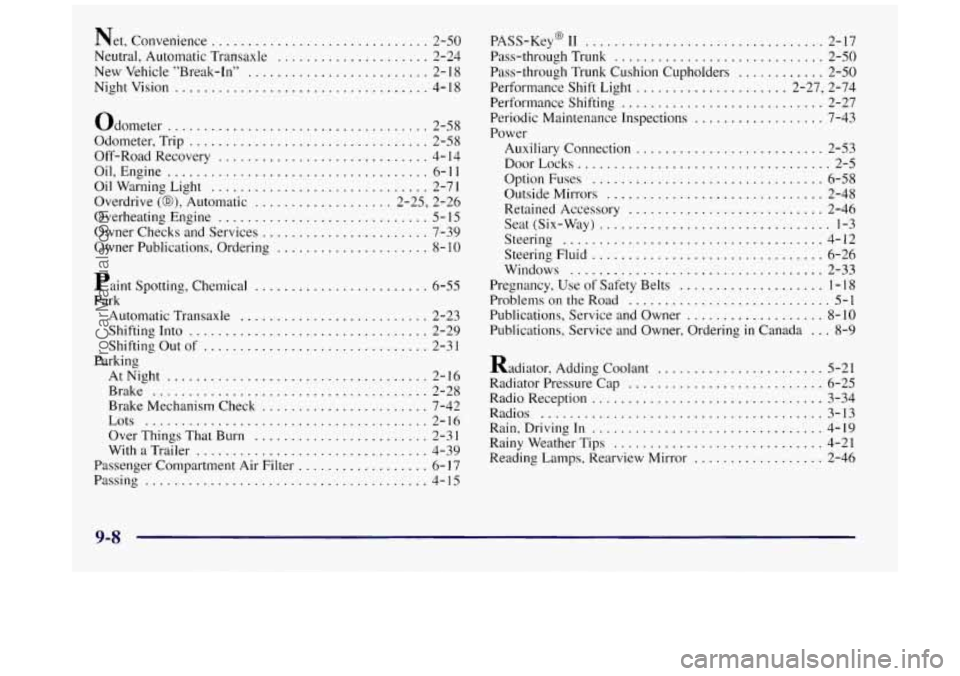
Net. Convenience .............................. 2-50
New Vehicle "Break-In"
......................... 2- 18
Nightvision ................................... 4-18
Neutral. Automatic Transaxle
..................... 2-24
odometer
.................................... 2-58
Odometer. Trip
................................. 2-58
Off-Road Recovery
............................. 4- 14
Oil. Engine
.................................... 6-11
Oil Warning Light
.............................. 2-7 1
Overdrive (0). Automatic ................... 2-25. 2-26
Owner Checks and Services
....................... 7-39
Owner Publications. Ordering
..................... 8- 10
Overheating Engine
............................. 5-
15
Paint Spotting. Chemical ........................ 6-55
Park
Automatic Transaxle
.......................... 2-23
Shifting Into
................................. 2-29
Shifting Out of
............................... 2-3 1
Parking
AtNight
.................................... 2-16
Brake
...................................... 2-28
Brake Mechanism Check
....................... 7-42
Lots
....................................... 2-16
Over Things That Burn ........................ 2-3 1
With a Trailer ................................ 4-39
Passing
....................................... 4-15
Passenger Compartment
Air Filter .................. 6- 17
PASS-Key 11 2-17
Pass-through Trunk Cushion Cupholders
............ 2-50
8 .................................
Pass-through Trunk ............................. 2-50
Performance Shift Light
..................... 2-27. 2-74
Performance Shifting
............................ 2-27
Periodic Maintenance Inspections
.................. 7-43
Auxiliary Connection
.......................... 2-53
DoorLocks
................................... 2-5
Option Fuses
...... ......................... 6-58
Outside Mirrors
.............................. 2-48
Retained Accessory
........................... 2-46
Seat (Six-Way)
................................ 1-3
Steering
.................................... 4-12
Steering Fluid
................................ 6-26
Windows
................................... 2-33
Pregnancy. Use
of Safety Belts .................... 1-18
Problems on the Road
............................ 5-1
Publications. Service and Owner ................... 8-10
Publications. Service and Owner. Ordering in Canada
... 8-9
Power
Radiator. Adding Coolant
....................... 5-21
Radiator Pressure Cap
........................... 6-25
Radio Reception
................................ 3-34
Rain. Driving
In ................................ 4-19
Rainy Weather Tips
............................. 4-21
Reading Lamps. Rearview Mirror
.................. 2-46
Radios
....................................... 3-13
9-8
ProCarManuals.com